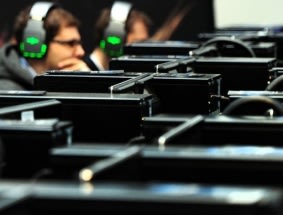he Bangko Sentral of the Philippines (BSP) released the newest Philippine money. The highlight of the change is the inclusion of the late former President and mother of current Philippine President, Corazon ‘Cory’ Aquino. Her picture will be joining Benigno "Ninoy" Aquino (who is now smiling at his picture by the way) at the new P500 peso bill. This makes 3 Aquinos in the P500 Peso Bill because, PNOY, as the Philippine president, is the one who signed the official bank note. According to PNOY, "The last time I checked, no other bank note all over the world has both parents and his son in the same bank note." This new face of P500 peso bill created a new record and history for Filipinos.

President Aquino is presented with the new 500-peso bank notes, featuring the images of both his parents and bearing his signature as President (overlaid). (Photo by RICHARD VIÑAS)
Source: http://mb.com.ph/

The design of the new P500 bill features the faces of President Cory Aquino and the late Sen. Ninoy Aquino. Jam Sisante
Source: http://www.gmanews.tv
A total of six denominations; P20, P50, P100, P200, P500, and P1,000 bills have now have new designs, which were especially designed to upgrade their security features so the public would easily detect if the money is real or fake.
Here are the details of the changes.
P20 Peso Bill

Front: Younger-looking Quezon at the front and pictures of the declaration of Filipino as a national language, and the Barasoain Church in Malolos, Bulacan.
Back: Picture of the Banaue Rice Terraces can be found, alongside an animal related to that area, the Palm Civet or most commonly known as the Musang.
P50 Peso Bill

Front: Younger-looking Osmeña and prints of the Leyte Landing and the First National Assembly on either side.
Back: Taal Lake and the Maliputo fish are featured.
P100 Peso Bill

Front: Young Roxas with pictures of the old BSP building in Intramuros, Manila, and the inauguration of the Second Republic.
Back: The Mayon Volcano in Albay and the whale shark (popularly known as butanding) can be found at the back of the new P100.
P200 Peso Bill

Front: Younger Diosdado Macapagal with photos of the Edsa People Power 2001 that elected her daughter, former President and now Rep. Gloria Arroyo of Pampanga, and the Independence House (former President Emilio Aguinaldo’s museum) in Kawit, Cavite.
Back: Sprawling Chocolate Hills in Bohol and the tarsier.
P500 Peso Bill

Front: Faces of the country’s two icons of democracy, former President Corazon “Cory” Aquino and former Sen. Benigno “Ninoy” Aquino Jr. It will also feature pictures of the Edsa People Power 1 in 1986 and the Benigno Aquino monument on Ayala Avenue, Makati City.
Back: Picture of the Subterranean Underground River in Puerto Princesa, Palawan and the Blue-Naped Parrot can be found.
P1,000 Peso Bill

Front: Almost similar pictures of Santos, Lim and Escoda are printed, as well as photographs of the centennial celebration of Philippine independence and the Medal of Honor, which was awarded to each of the trio.
Back: Pictures of Tubbataha Reefs Natural Park and the South Sea pearl.
All bank notes will have a color almost similar to the ones used on the current bank notes—orange for P20, red for P50, bluish violet for P100, green for P200, black/gold for P500 and blue for P1,000.


